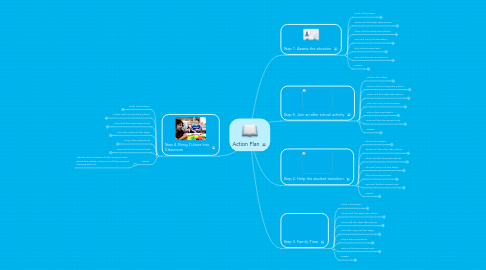
1. Step 1. Assess the situation
1.1. What is this step?
1.1.1. See what category your ELL falls into. See how much English they know and what level fluency they are at.
1.2. Where will this step take place?
1.2.1. School
1.3. When will this step take place?
1.3.1. As soon as you meet the child.
1.4. Who will carry out this step?
1.4.1. The teacher.
1.5. Why is this important?
1.5.1. This is important because you need to plan around the needs of the student. You need to be able to understand their background to see if the student needs more or less attention.
1.6. How will this be carried out?
1.6.1. By speaking with the student and with the family of the student, you can assess whether the student speaks English in his home and what the background of the student is.
1.7. Assess
1.7.1. Try helping an ELL student without knowing their background and you will realize how important this step is.
2. Step 5. Join an after school activity
2.1. What is this step?
2.1.1. Encourage the child to join an after school activity.
2.2. Where will this step take place?
2.2.1. At the school
2.3. When will this step take place?
2.3.1. After school hours.
2.4. Who will carry out this step?
2.4.1. The child and the family
2.5. Why is this important?
2.5.1. This is important because joining an after school program is one of the best ways for that child to make friends. Whether it is sports or something else, find something the child enjoys and has people that the child can relate to and have fun with.
2.6. How will this be carried out?
2.6.1. Give the child a variety of options and encourage them to do one of them. Let the teacher or coach know about the student's background and help them fit in any way possible.
2.7. Assess
2.7.1. Ask the child about their after school activity to see if they are enjoying it and to see whether or not this is an important step.
3. Step 2. Help the student transition
3.1. What is this step?
3.1.1. Help to teach the student new things about the school and aide them in their transition in any way possible. In addition help the student with any vocabulary issues as they adjust to the new language.
3.2. Where will this step take place?
3.2.1. School
3.3. When will this step take place?
3.3.1. During school hours
3.4. Who will carry out this step?
3.4.1. Teachers and school counselors
3.5. Why is this important?
3.5.1. To make the student feel comfortable transitioning into their new environment.
3.6. How will this be carried out?
3.6.1. Give the student more one-on-one time during class hours. During the first week of class have them shown around the building so that they get familiar with the area to help their transition.
3.7. Assess
3.7.1. Ask the other teachers and peers if the student seems to be gaining confidence and friends as the year goes on.
4. Step 3. Family Time
4.1. What is this step?
4.1.1. Encourage the family to help with the student's English language learning in any way possible.
4.2. Where will this step take place?
4.2.1. Home
4.3. When will this step take place?
4.3.1. After school hours
4.4. Who will carry out this step?
4.4.1. The student's family
4.5. Why is this important?
4.5.1. The child spends just as much time learning from their family as they do in the schools. If the family can help with the transition it can make the job easier on the teacher.
4.6. How will this be carried out?
4.6.1. Have the family assist with learning English as a second language as much as possible. Encourage the whole family to learn English and to practice speaking it in the home to give the student extra practice.
4.7. Assess
4.7.1. See if the family is helping the student at home by checking in with the family periodically.
5. Step 4. Bring Culture into Classroom
5.1. What is this step?
5.1.1. Help the student transition by introducing his culture to the other students. Make him feel more comfortable in the school.
5.2. Where will this step take place?
5.2.1. In the classroom.
5.3. When will this step take place?
5.3.1. During school hours.
5.4. Who will carry out this step?
5.4.1. Teachers and Principal
5.5. Why is this important?
5.5.1. This is important to show the child that you acknowledge their situation and where they are coming from. It also shows that you are welcoming their culture as well as showing the other students what the child is like.
5.6. How will this be carried out?
5.6.1. Put up posters that relate to the child, make the child's favorite food, play music that they can relate to, include vocabulary that the child knows in your lesson, and etc.
5.7. Assess
5.7.1. Ask the other children if they learned more about the child's culture and if they enjoyed learning about it.
